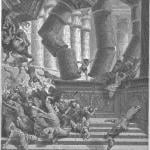
We’re just back from a very good Italian dinner at the Chef Alfredo Ristorante Italiano in Cedar City with a friend who lives there in town. Again, I’m amazed at the good restaurants and good theater that can now be found in southern Utah.
Before going to our friend’s house and then, with her, out to dinner, we watched a matinee performance of Neil LaBute’s play How to Fight Loneliness, directed by the Utah Shakespeare Festival’s longtime co-artistic director David Ivers, who has just taken a position down in Tucson, and with a cast of three (Tessa Auberjonois, daughter of René Auberjonois; Corey Jones; and the local favorite and now-sole Festival artistic director, Brian Vaughn).
The acting was superb.
I have mixed feelings, though, about the play itself.
Neil LaBute is an award-winning playwright and film director who, for whatever it’s worth, converted to the Church of Jesus Christ of Latter-day Saints while a student at Brigham Young University but who has since resigned his membership in the Church.
I’m certainly no authority on either Mr. LaBute or his work, but I seem to recall that one of the reasons for his departure from Mormonism was that he felt that Mormonism constrained him, that he could not fully mature as an artist while a Latter-day Saint.
So I was curious to see How to Fight Loneliness, wondering whether I might be able to detect what in it might have been impossible for a Latter-day Saint to write. Mr. LaBute has the reputation, I think, of being “edgy.”
Well, the most obvious thing is the language. I didn’t arrive intending to do it, but I found myself counting the f-bombs. My final total, which I think is pretty accurate, plus or minus one or two, came to 89. And that’s not counting various other profanities and obscenities.
The small theater in which the play was performed was only about half full, and I can well imagine that Utah Mormon sensibilities represent a significant factor in the low attendance.
But ripe language, in my judgment, doesn’t constitute real “edginess.” (Anyway, I grew up working with construction crews in southern California, and particularly with a mechanic whom I regarded as the Shakespeare or Milton of profanity, so I’m pretty impervious to, and unfazed by, swearing.)
What I was looking for, I guess, was intellectual “edginess.” Adventurous ideas. Provocative thinking. Profundity. And, I confess, I didn’t see much of that in How to Fight Loneliness. For me, in theater, the gold standard for that kind of conceptual richness or philosophical depth might be — beyond obvious examples like Hamlet, King Lear, Othello, and so forth — something like T. S. Eliot’s Murder in the Cathedral, which, sadly, I’ve never seen (and may never see) performed. Or, perhaps, Michael Frayn’s Copenhagen, which my wife and I saw brilliantly done in London a number of years ago.
I hate to spoil the plot, but How to Fight Loneliness deals with euthanasia. My wife found the story predictable (except for the insertion of a distinctly melodramatic element in the third scene), but points out that the real drama of the play consists in the (very) emotional and sometimes surprising interaction of the characters. There were a few points that both my wife and I found rather moving.
Predictable isn’t the word that came to my mind, but the play is unrelentingly (and, therefore, a bit wearyingly) intense, and, I thought, somewhat wordy. And there were a couple of places where I found it incoherent or, perhaps, to be more precise, self-contradictory. But it did do a good job, I think, of portraying the difficult issue of suffering from a hopeless, incurable, and fatal disease. The sheer pain of it. And the ways in which such suffering hopelessness can strain a relationship. Moreover, I should in fairness point out that the audience gave the cast a standing ovation.
If you can handle very rough language and a whole lot of loud and raw emotion, you might find How to Fight Loneliness thought-provoking and interesting. But there were no ideas in it, so far as I could tell, that would be beyond the reach or outside the range of a serious Latter-day Saint writer or thinker.
“We will yet have Miltons and Shakespeares of our own,” prophesied Elder Orson F. Whitney (who would serve 1906-1931 as member of the Quorum of the Twelve) in 1888. “God’s ammunition is not exhausted. His brightest spirits are held in reserve for the latter times. In God’s name and by his help we will build up a literature whose top shall touch heaven, though its foundations may now be low in earth.”
Elder Whitney’s hope hasn’t yet been fulfilled. And I wish that Neil LaBute were still with us to help us move toward the fulfillment of that prediction. But I believe that the prophecy will someday come true.
Posted from St. George, Utah











